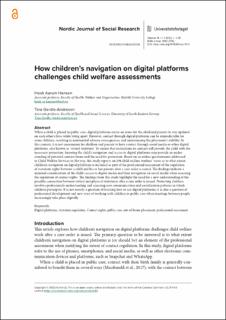| dc.contributor.author | Hansen, Heidi Aarum | |
| dc.contributor.author | Gerdts-Andresen, Tina | |
| dc.date.accessioned | 2024-02-05T15:12:03Z | |
| dc.date.available | 2024-02-05T15:12:03Z | |
| dc.date.created | 2023-05-16T10:12:12Z | |
| dc.date.issued | 2023 | |
| dc.identifier.citation | Nordic Journal of Social Research. 2023, 14 (1), 1-15. | en_US |
| dc.identifier.issn | 1892-2783 | |
| dc.identifier.uri | https://hdl.handle.net/11250/3115690 | |
| dc.description.abstract | When a child is placed in public care, digital platforms create an arena for the child and parents to stay updated on each other’s lives while living apart. However, contact through digital platforms can be unpredictable for some children, resulting in unintended adverse consequences and undermining the placement’s stability. In this context, it is not uncommon for children and parents to have contact through social media or other digital platforms, also known as ‘virtual visitation’. To ensure that restrictions on contact will provide the child with the necessary protection, knowing the child’s navigation and access to digital platforms may provide an understanding of potential contact forms and the need for protection. Based on an online questionnaire addressed to Child Welfare Services in Norway, this study reports on 196 child welfare workers’ views as to what extent children’s navigation on digital platforms is included as part of the professional assessment of the regulation of visitation rights between a child and his or her parents after a care order is issued. The findings indicate a minimal consideration of the child’s access to digital media and their navigation on social media when assessing the regulation of contact rights. The findings from this study highlight the need for a new understanding of the possible connection between virtual and physical visitations after a care order is issued. Protecting children involves professionals understanding and assessing new communication and socialization patterns in which children participate. It is not merely a question of learning how to use digital platforms; it is also a question of professional development and new ways of working with children in public care when meetings between people increasingly take place digitally. | en_US |
| dc.language.iso | eng | en_US |
| dc.publisher | Universitetsforlaget | en_US |
| dc.rights | Navngivelse 4.0 Internasjonal | * |
| dc.rights.uri | http://creativecommons.org/licenses/by/4.0/deed.no | * |
| dc.subject | digital platforms | en_US |
| dc.subject | visitation regulation | en_US |
| dc.subject | contact rights | en_US |
| dc.subject | public care | en_US |
| dc.subject | out-of-home placement | en_US |
| dc.subject | professional assessment | en_US |
| dc.title | How children’s navigation on digital platforms challenges child welfare assessments | en_US |
| dc.type | Peer reviewed | en_US |
| dc.type | Journal article | en_US |
| dc.description.version | publishedVersion | en_US |
| dc.rights.holder | © 2023 Author(s). | en_US |
| dc.subject.nsi | VDP::Samfunnsvitenskap: 200::Sosiologi: 220 | en_US |
| dc.source.pagenumber | 1-15 | en_US |
| dc.source.volume | 14 | en_US |
| dc.source.journal | Nordic Journal of Social Research | en_US |
| dc.source.issue | 1 | en_US |
| dc.identifier.doi | 10.18261/njsr.14.1.1 | |
| dc.identifier.cristin | 2147747 | |
| cristin.ispublished | true | |
| cristin.fulltext | original | |
| cristin.qualitycode | 1 | |

